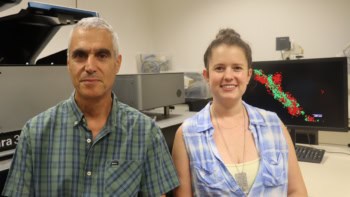
Stereotactic radiosurgery (SRS) treats small tumours in the brain by delivering high doses of radiation to the target area with sub-millimeter precision, preserving the surrounding healthy tissue. Initially, the treatment was focused on patients with a small number of lesions. But interest in the approach has broadened as clinicians have discovered that survival times and benefits persist even for more complex cases.
Treating multiple brain metastases simultaneously means fewer patient trips to the clinic, and minimizes the amount of time that patients need to be immobilized while treatment takes place. It also allows more people to benefit from more productive use of hospital resources.
But the challenge comes in finding a more efficient way of assessing the treatment plan, which already posed a number of technical hurdles. “Many of those lesions are very small targets,” points out Jacqueline Maurer, a medical physicist based in the US.
The delivery dose can be difficult not just to model, but also to measure. Using the most common detector arrays, the spacing between individual sensing elements is too coarse. There are time constraints to consider too – for example, using a single device to evaluate 10 targets one by one requires the treatment plan to be delivered 10 times, which is impractical.
The solution is a precision brain phantom that features as many as 29 parallel imaging planes, each one loaded with radiation-sensitive film spaced at 5 mm increments. “You can deliver the plan a single time and get high-resolution absolute dose measurements by arranging the film so that it bisects each of the lesions,” Maurer explains.
Customer-led design
Unable to realize a set-up using existing materials, Maurer sketched out her idea to CIRS, a US manufacturer of tissue-equivalent phantoms and simulators for medical imaging, radiation therapy and procedural training. “I thought this geometry might work, but there wasn’t a product on the market and so I approached Vladimir, one of the engineers at CIRS,” Maurer remembers.
Back in the factory, the CIRS team worked up several prototypes and added a range of useful features. The phantom – dubbed model 037 – measures 150 mm (W) x 190 mm (H) x 170 mm (L) to cover variations in brain anatomy, and weighs 5 kg. Constructed from brain-equivalent epoxy resin, the unit is designed to exhibit a linear attenuation that’s within 1% of real tissue from 50 keV to 15 MeV.
“We wanted to make multi-lesion treatment available to our patients, but at the same time we didn’t want to risk inaccuracies in the procedure,” says Maurer. “The phantom let us do it confidently.” This includes running a sequence of patient quality assurance (QA) and characterization tests to ensure that the radiation is being delivered as expected.
End-to-end testing
In the clinic, Maurer and her colleagues were able to take the QA device through each part of the process that the patient goes through. “You can put the phantom on the CT scanner, take an image, and send the information to your treatment planning system,” she explains. “And from there you can carry out the QA steps, which include imaging the phantom on the linear accelerator (linac) and checking the film to see how well you did.”
SRS treatments can involve very steep dose gradients, which puts extra pressure on the team to make sure that everything is positioned correctly. “You could have a 40% dose error for just being 1 mm off target,” Maurer cautions.
The precision with which CIRS is able to construct the product is a key part of the SRS multi-lesion brain QA phantom’s success. When loaded with sheets of radiation-sensitive film – also available from the firm – each layer in the device is exactly 5 mm apart, according to the specification.

Holding the phantom together are four threaded bolts, positioned one in each corner, but that’s not their only feature. Because the bolts are made of materials with different Hounsfield units – a measure of linear attenuation – the combination provides X-ray visible reference structures that can be used for positioning by the linac’s onboard imaging software.
“Automatic image registration algorithms tell you exactly what your shifts in rotation need to be to get your phantom in precisely the right spot,” says Maurer. “And if you agree with the match then the alignment software will automatically send those shifts and rotations to your machine, which make those hairline adjustments for you.”
Just like during treatment, the phantom can be positioned complete with couch kicks (table rotations) so that the geometry is the same as the patient geometry. “What you see on the film is an actual representation of the dose to the patient,” Maurer concludes.
For full product specifications, visit www.cirsinc.com




